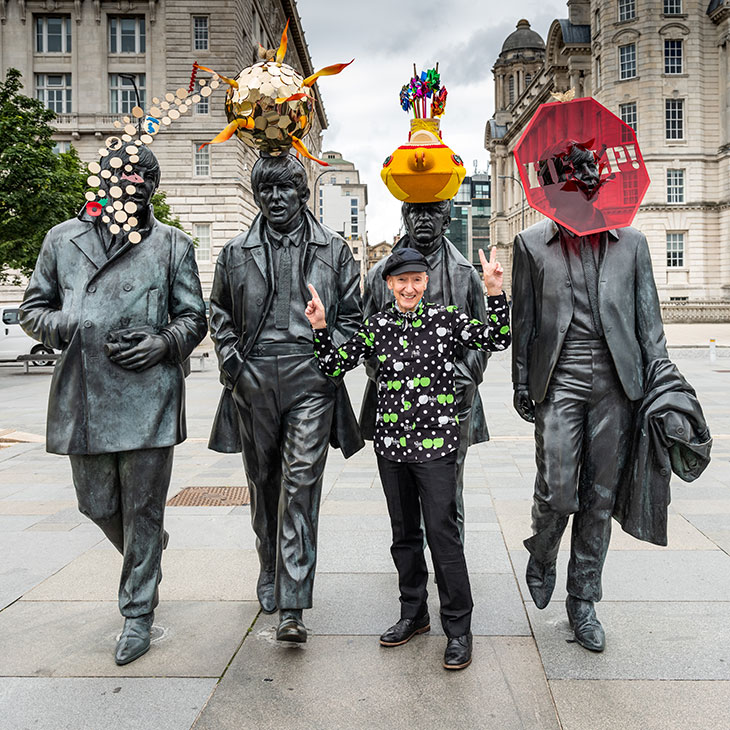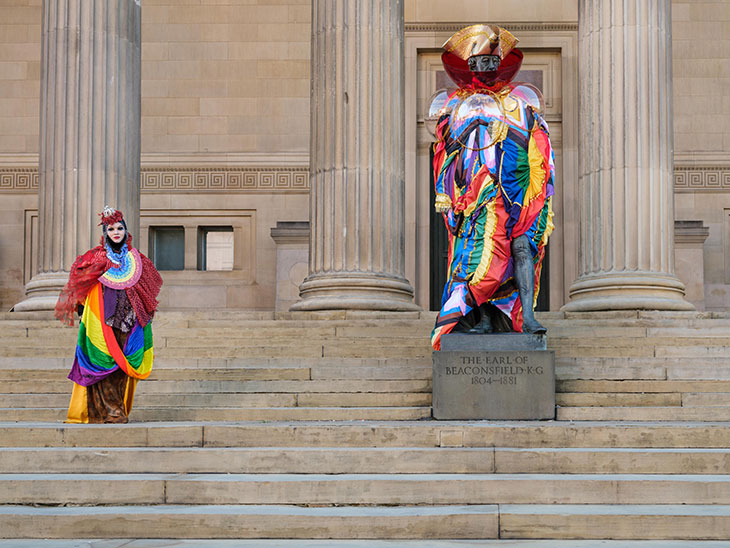Not all interactions with statues should be interpreted as political commentary. There is a long tradition of placing traffic cones on the heads of bronze, stone or marble figures, for example, and I’d guess that for most offenders this is not a comment on the life of the person depicted (if they can even identify them correctly). Rather there is a sense that these are public artworks to be treated as the public – and more often pigeons – sees fit, although they usually blend into our cities and daily lives without much notice until a drunken fresher stumbles past some roadworks and gets a bright idea.
That the role of public statues is undergoing a period of re-examination is the premise for Statues Redressed, a 90-minute documentary that premiered on Sky Arts this week. Instead of falling on drunken freshers, the responsibility for ‘dressing’ a series of statues in the city of Liverpool is given to a more sober selection of artists and designers. Each statue is assigned to a different artist. As contributions to an often polarising debate, many of the responses are quite anodyne. The statues of the Beatles strolling along the waterfront, for instance, are given hats, designed by the Liverpudlian milliner Stephen Jones and each inspired by one of the band’s songs. Once they’re wearing their slightly ridiculous new hats, the Beatles look like they’re off to a fancy dress party together – although who would wear a costume based on their own songs?

Milliner Stephen Jones with the hats he designed for Andy Edwards’ Beatles statue, Pier Head, Liverpool. Photo: David Edwards; © Sky UK Ltd
The ‘redressing’ of statues of Queen Victoria and William Gladstone responds more directly to the conversation around monuments of controversial historical figures. Gladstone, whose family wealth came from plantation and slave ownership, is wrapped like one of Christo’s sculptures in a pan-African flag designed by Larry Achiampong. Queen Victoria is given a headscarf and dress made from the sacking used in the cotton trade in the American South. The patterned fabrics are a reference to the intriguing story of Martha Ricks, a Black woman who made a patchwork quilt for the queen and travelled from her home in Liberia to present it to her.
Opinions are canvassed from members of the public who happen to be wandering past the statues; the feedback is generally positive. The show then cuts to Nigel Farage’s response on GB News. As one might imagine, he struggles with the idea that Britain’s heroes and history might be in need of re-examination. So, it appears, do one or two other people. A day after the GB News broadcast, Victoria is found stripped of her new outfit. The culprits remain unknown.

Daniel Lismore with the outfit he designed for the 1883 statue of Benjamin Disraeli at St George’s Hall. Photo: David Edwards; © Sky UK Ltd
The most impressive makeover is given to a statue of Benjamin Disraeli by the artist and activist Daniel Lismore. The prime minister was known for his flamboyant, dandyish style and had a number of intense relationships with men. Lismore, who has himself been described as ‘England’s most eccentric dresser’, outfits him in a Pride-themed multicoloured silk cloak, metallic three-point hat, and a cape bearing the words ‘Will the real Empress of India please stand up?’ (Disraeli gave this title to Queen Victoria). It’s a joyous transformation, one which Disraeli may have enjoyed. The passers-by who stop to look at it certainly seem to; one person remarks that she’ll look Disraeli up on Wikipedia later.
It’s an interesting way to get people to pay more attention to statues. For a few, the project may well have deepened their understanding of the figures placed on plinths. But once the costumes are gone, the job of dressing up statues will be given back to the pigeons and boozers who have been commenting on our historical figures for so long.
Statues Redressed was broadcast on 18 October on Sky Arts.














![Masterpiece [Re]discovery 2022. Photo: Ben Fisher Photography, courtesy of Masterpiece London](http://zephr.apollo-magazine.com/wp-content/uploads/2022/07/MPL2022_4263.jpg)
‘Like landscape, his objects seem to breathe’: Gordon Baldwin (1932–2025)